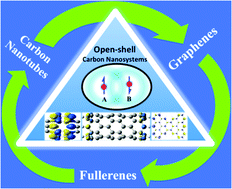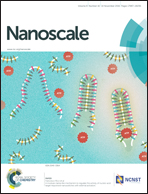Role of a singlet diradical character in carbon nanomaterials: a novel hot spot for efficient nonlinear optical materials†
Abstract
Carbon atoms have the potential to produce a variety of fascinating all-carbon structures with amazing electronic and mechanical properties. Over the last few decades, several efforts have been made using experimental and computational techniques to functionalize graphene, carbon nanotubes and fullerenes for potential use in modern hi-tech electronic, medicinal, optical and nonlinear optical (NLO) applications. Since photons replaced electrons as a carrier of information, the field of NLO material design has drawn immense interest in contemporary materials science. There have been several reports of bridging the gap between the exciting fields of carbon nanomaterials and NLO materials by functionalizing carbon nanomaterials for potential NLO applications. In contrast to previous reports of the design of third-order NLO materials using conventional closed-shell materials, a novel strategy using open-shell diradical molecular systems has recently been proposed. Quantum chemically, diradical character is explained in terms of the instability of the chemical bonds in open-shell molecular systems. Interestingly, several carbon nanomaterials, which naturally possess open-shell singlet configurations, have recently gained momentum in the design of these classes of open-shell NLO materials with excellent NLO properties, stability and diversity. The present review establishes a systematic sequence of different studies (spanning over two decades of intense research efforts), starting from the simplest theoretical two-site diradical model, continuing to its experimental and theoretical realization in actual chemical systems, and finally applying the abovementioned model/rule to novel carbon nanomaterials to tune their NLO properties, particularly their second hyperpolarizability (γ). In the present report, we highlight several recent efforts to functionalize carbon nanomaterials by exploiting their open-shell diradical character to achieve efficient third-order NLO properties. Several issues and opportunities are discussed, including the inherited disadvantages of both experimental (the high reactivity and short life of diradical compounds) and quantum (need for multi-reference methodology) techniques when dealing with carbon nanomaterials. A comparative analysis of several quantum chemical investigations, along with contemporary experimental results, will be performed to emphasize the core issues and opportunities related to carbon nanomaterials with singlet open-shell diradical character. Thus, the present review will highlight carbon nanomaterials with diradical/biradical character for their prospective applications in the NLO field.



 Please wait while we load your content...
Please wait while we load your content...